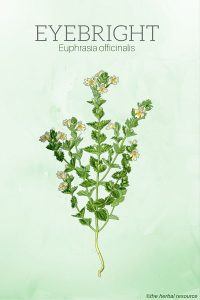Eyebright contains carbohydrates, tannins, alkaloids, sterols, phenolic acids, iridoid glycosides (aucubin, loganin and verbenalin), flavonoids, amino acids, essential oils and vitamins A and C.
A Herb for the Eyes
Ever since the Middle Ages, eyebright has been used to treat bloodshot and irritated eyes.
It is believed that this application arose because of “signature doctrine”, a method dating from the time of Pedanius Dioscorides (40 – 90 AD) stating that any plant that resembles specific body part can be used to treat ailments afflicting it. In this case, the flowers of eyebright have stripes and dots, not unlike bloodshot eyes.
Eyebright has been associated with eye health for a very long time, and from the 11th century to our days, the herb has been used as an herbal remedy for various eye diseases.
It has been used both internally and externally to soothe tired and bloodshot eyes, and to treat styes (an infection of the sebaceous glands at the base of the eyelashes), conjunctivitis and inflammation of the eyelid edges (blepharitis).
Eyebright was also used traditionally to treat sore and itchy eyes caused by colds and allergies.
An herbal tea made from the herb was considered a useful remedy for sinusitis, rhinitis, an irritation and inflammation of the mucous membrane inside the nose, and other respiratory infections.
No one should practice self medication when it comes to eye diseases without first consulting a professional health care worker. Some eye infections can be so severe that they require immediate antibiotic treatment in order to avoid permanent damage.
Scientific Evidence
Very little scientific research is available when it comes to the health properties of eyebright.
Even though the herb has been used for centuries as a remedy for conjunctivitis and bloodshot eyes, many herbalists believe it is not enough in order to recommend its use in modern herbal medicine. Their arguments for refraining from using eyebright is because no studies so far have been able to confirm any of the alleged medicinal effects of the herb.
Thorough studies of the herb’s ingredients were not made until 1999 and then it was established that some of the ingredients found in the plant have anti-inflammatory, antibacterial and astringent properties.
The substances aucubin, loganin, and verbenalin have been shown to have a positive effect on inflammation in laboratory animals. Aucubin stimulates the production of proteins that are involved in the healing processes, which may explain the use of eyebright as a healing herb.

Thanks for the Info.